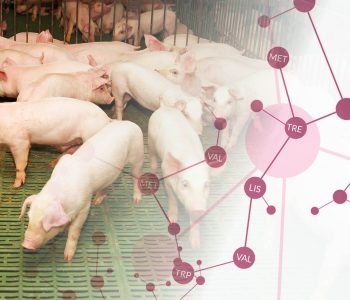Advancements, Implications, and Constraints of Low-Crude-Protein Diets in Swine Farming
| Introduction |
Feeding programs in pig production are usually divided into three phases: nursery, growth, and finishing (Rostagno et al., 2017). In each of these phases, it is essential to provide an adequate supply of dietary crude protein (CP) to meet the requirements for essential amino acids and nitrogen (N) for non-essential amino acid synthesis (van Milgen and Dourmad, 2015).
Moreover, the inclusion of the amino acid Isoleucine in diets depends on its economic value and the specific feeding program.
Experimental studies have shown that even lower levels of CP can be achieved by supplementing amino acids such as Histidine, Leucine, and Phenylalanine.
Indeed, altering the CP level in the diet, even while keeping the ideal ratios of essential amino acids with Lys, has shown negative effects on swine performance.
Benefits and Limitations of Low-Crude-Protein Diets
From a performance standpoint:
While research has focused on ensuring sufficient provision of essential amino acids, the literature provides explanations for the detrimental effects on swine performance when low-crude-protein diets are employed.
Pigs fed low-crude-protein diets have exhibited decreased blood levels of non-essential amino acids, especially Arg, Gln, Glu, and Pro (Zhang et al., 2013).
| Meta analysis |
Due to discrepancies in the literature and the practical implications for swine formulation strategies, a meta-analysis was conducted to determine the minimum CP level that would not compromise swine growth performance.
Additionally, the supplementation of industrial amino acids allows for the reduction of protein sources like soybean meal, which contains biologically active compounds such as isoflavones, saponins, and bioactive peptides that are essential for maintaining performance (Rochell et al., 2015).
- Assessment of various levels of crude protein.
- Comparable standardized ileal digestible lysine (SID Lys) and metabolizable energy (ME) between control and low-crude-protein treatments.
- Ensuring all essential amino acids in the diet met or surpassed the ideal ratio with Lys (NRC, 2012).
- Clearly documented performance outcomes.
The meta-analysis study utilized the NLIMIXED procedure of SAS (SAS, Inc., Cary, NC, USA) and employed a nonlinear statistical model.
Nursery Phase
According to NRC (2012) and Brazilian Tables (Rostagno et al., 2017), a corn and soybean meal-based diet for 7 kg body weight pigs typically contains approximately 20.5% CP.
The suggested minimum CP level for nursery pig diets is lower than the levels recommended by NRC (2012) and Brazilian Tables (Rostagno et al., 2017), suggesting that CP levels lower than those provided in the Tables can be used for diet formulation in this phase.
By considering the SID Lys:CP ratio, it was determined that 6.6% is the upper threshold beyond which both average daily gain (ADG) and feed efficiency would be compromised.
Growth phase
In contrast to the nursery phase, diets in the growth phase are formulated with a lower crude protein level.
According to the statistical model used in the current meta-analysis:
For a similar phase, NRC (2012) and Brazilian Tables (Rostagno et al., 2017) suggest 15.7% and 18.9% CP, respectively. The result found in the present study falls within these CP ranges.
Finishing phase
Protein is an expensive nutrient, and due to the increased feed intake in the finishing phase, nutrient utilization efficiency directly impacts production system costs.
As per the Tables (NRC, 2012; Rostagno et al., 2017), a diet for the initial finishing phase (70 to 100 kg) can be formulated with around 12.3% CP, whereas a diet for the second finishing phase (100 kg to slaughter) with approximately 11.0% CP, all the while maintaining the suggested concentration of essential amino acids.
These levels are within the range recommended by NRC (2012) for pigs in the first (12.1% CP) and second (10.5% CP) finishing phases, likely due to the consideration of both phases in our model.
On the other hand, the suggested levels are lower than the recommendations provided by the Brazilian Tables (Rostagno et al., 2017) for pigs in the finishing phase.
Thus, lower CP levels than those recommended in the Brazilian Tables (Rostagno et al., 2017) can be used without compromising zootechnical performance.
Taking into account the average daily gain (ADG), it is possible to supplement up to 0.24% L-lysine, which is equivalent to 0.30% L-lysine HCl or 0.40% L-lysine sulfate supplementation.
| Conclusions |
Based on the meta-analysis, considering ADG and feed efficiency, the minimum crude protein levels were estimated as follows:
- 18.4% and 18.3% for nursery pigs;
- 16.1% and 16.3% for growth,
- and 11.6% and 11.4% for finishing pigs, respectively.
This report is based on the article “Rocha, G. C., Duarte, M. E., & Kim, S. W. (2022). Advances, Implications, and Limitations of Low-Crude-Protein Diets in Pig Production. Animals, 12(24), 3478.”
You may also like to read: “The impact of amino acid levels during rearing on broiler breeder productivity.”
Source: This article was originally published as content in portuguese in nutriNews Brasil 2023
